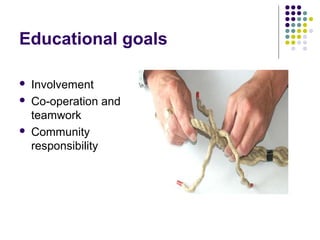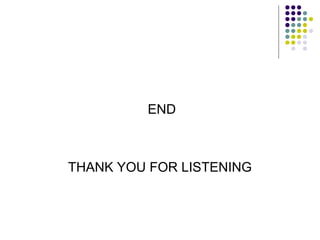COLLABORATIVE LEARNING
- 1. Collaborative Learning Jamlick Bosire New Horizon Consultancy
- 3. From the above we deduce that We Learn: 10% of what we read 20% of what we hear 30% of what we see 50% of what we both see and hear 70% of what is discussed with others 80% of what we experience personally 95% of what we teach someone else
- 4. 1970 3. READING 2. COMPUTATION 1. WRITING 2000 3. INTERPERSONAL SKILLS 2. PROBLEM SOLVING 1. TEAMWORK According to Fortune 500 Companies: The Top Skills sought by employers
- 6. Teaching vs learning John Amos Comenius, a 16th Century scholar; summarised the approach that teaching should follow, “The main object is to find a method by which teachers teach less but learners learn more”, proving that current problems have noble pedigrees.
- 7. Collaborative learning Collaborative learning in the ECDE level means children working together to accomplish a task, or to achieve a certain goal. We humans, like many other animals, are social beings. We are more successful if we use our intelligence to work with others to achieve more. To be able to work collaboratively is a skill we all need.
- 8. Educational goals Involvement Co-operation and teamwork Community responsibility
- 9. Assumptions about learning Learning is an active constructive process Learning depends on rich contexts Learners are diverse Learning is inherently social
- 10. … it is those of us who can solve problems while working with others who succeed… A successful Scientist must be able to cooperate with other scientists, with technicians and with students. An executive, to cooperate with other executives, salespersons, suppliers and superiors. (Dunne and Bennett, 1990)
- 11. . . . collaborative learning fosters the development. . . collaborative learning fosters the development of critical thinking through discussion, clarificationof critical thinking through discussion, clarification of ideas, and evaluation of others' ideas. . . .of ideas, and evaluation of others' ideas. . . .
- 12. Approaches Collaborative learning Co-operative learning Problem-based learning Writing groups Peer teaching Learning communities Discussion groups
- 13. In a teaching situation you are likely to face challenges such as: How to help the pupils to acquire more knowledge? How to make learning more interesting for the pupils? How to motivate the pupils? How to challenge the pupils so that they can perform better? One way to overcome this is through collaborative learning.
- 14. Why use collaborative learning? Pupils learn qualities of humility, self-control, fair play, patience and leadership. Builds pupils’ confidence and character. promote pupils learning and academic achievement enhance pupil satisfaction with their learning experience help pupils develop skills in oral communication develop pupil's' social skills promote pupil self-esteem increase pupil retention develop a community of learners
- 16. Can you read the following aloud "It is the long history of humankind (and animal kind, too) those who learn to collaborate and improvise most effectively prevail." - Charles Darwin
- 17. "If you have an apple and I have an apple and we exchange these apples then you and I will still each have one apple. But if you have an idea and I have an idea and we exchange these ideas, then each of us will have two ideas." - George Bernard Shaw
- 18. Collaboration is important not just because it's a better way to learn. The spirit of collaboration is penetrating every institution and all of our lives. So learning to collaborate is part of equipping yourself for effectiveness, problem solving, innovation and life-long learning in an ever-changing networked economy. Don Tapscott
- 19. END THANK YOU FOR LISTENING
Editor's Notes
- Just like our earlier discussions on active learning, small group work, the idea is to involve students more in their own learning process. Comenius - Known today as the "Father of Modern Education," pioneered modern educational methods. Comenius was asked to be the first President of Harvard College -- and declined. Comenius was the first to use pictures in a textbook. Comenius was the first to promote continuing education -- and the first to advocate equal education for all, including women and the poor. Just like our earlier discussions on active learning, small group work, the idea is to involve students more in their own learning process.
- Collaborative learning represents a significant shift away from the typical teacher-centred or lecture-centred milieu in higher education class rooms. In collaborative classrooms, the lecturing/listening/note-taking does not disappear but it lives alongside other processes that are based on students’ discussion and active work with the course material. Lecturers who use collaborative learning approaches tend to think of themselves less as experts transmitters of knowledge and more as coaches or midwives of a more emergent learning process. The process is based on establishing a community of learners.
- Since we use collaborative learning to help students learn more effectively it is important to consider teaching strategies that go beyond a mere mastery of content and ideas. Collaborative learning promotes and educational agenda that encompasses several intertwined rationales Involvement – by its very nature collaborative learning is both socially and intellectually involving. Research has shown that it makes a significant difference in student performance and subsequently student retention. Cooperation and teamwork – In collaborative activities students inevitably encounter difference and have to work to recognise and deal with it. This helps build a community of learners. Community – Habits of participation and responsibility to a subject/classroom community can help in the broader communities. Collaborative learning encourages students to develop an active voice in shaping their ideas and values and also developing a sensitive ear to the views and opinions of thers. In the hands of an expert rope maker loose strands can be skilfully woven together to form a rope with greater strength and durability. The same can be said of a committed and creative lecturer. Don’t get me wrong – there will be cynics – one colleague in another institution- was undertaking collaborative learning in the form of group work when his Dean called and said, “I see you’re doing group work, I’ll call back when you’re teaching!”
- Active constructive process – to learn new information, ideas or skills students have to work actively with them in purposeful ways. In collaborative learning situations students are creating something new by integrating the new material with something they already know or use it to reorganise what they thought they knew. Rich contexts – the idea of collaborative learning activities is to immerse students in challenging tasks or questions. Rather than beginning with facts and ideas and then moving to applications CL activities frequently begin with problems This changes the role of the student from distant observer to practitioner. Rich context challenge students to practice and develop higher-order reasoning and problem-solving skills. Diversity – Our students bring multiple perspectives to the classroom – diverse backgrounds, learning styles, experiences and aspirations. Ashby's Law of requisite variety. Inherent sociability- collaborative learning produces intellectual synergy of many minds coming to bear on a problem and the social stimulation of mutual engagement of mutual engagement in a common endeavour (Voltaire – there is no problem a meeting of minds cannot resolve)
- Cooperative efforts result in participants striving for mutual benefit so that all group members: gain from each other's efforts. (Your success benefits me and my success benefits you.) recognize that all group members share a common fate. (We all sink or swim together here.) know that one's performance is mutually caused by oneself and one's team members. (We can not do it without you.) feel proud and jointly celebrate when a group member is recognized for achievement. (We all congratulate you on your accomplishment!).


















